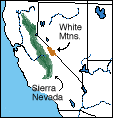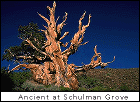
For eons the bristlecones (Pinus longaeva & aristata) have flourished atop the arid mountains of the Great Basin, from Colorado to California, enduring extreme hardships and silently adjusting to their environment. Their exquisite beauty was known to few. Their great age was known to nonenot until 1953.
First we must go back to 1932 when Edmund Schulman began his career in dendrochronology as an assistant to A.E. Douglass of the Laboratory of Tree-Ring Research, University of Arizona. Schulman had a background in astronomy and, like his mentor, he related cosmic events to the science of tree-ring dating. For the next 20 years he conducted climatic research throughout the western states. At that time our records of climatic conditions in western America were relatively short, with sensitive tree-ring records showing only a few centuries. Schulman thought it imperative that he/science push the chronology further into the past.
During the years 1939-1953 Schulman's focus was on conifers in the lower forest zones, the habitat of the piñon and Douglas-fir. The longer records of the Giant Sequoia (Sequoiadendron giganteum) were not used because of the semi-humid region they grow in. Then he learned that certain species of trees in the upper-forest zones, growing under stressful conditions, showed sensitive records of drought in their growth-ring sequences, much more so than the rings of trees living in lower zones that can be unreliable due to ground water, etc. The short, distorted and dwarfed trees of the upper treelines were now his focus. He discovered a Douglas-fir 600 yrs. old in Mesa Verde National Park, Colorado, an 800 year old bristlecone on Mt. Evans in Nevada, and a piñon pine of 975 yrs. in Utah. With all this data, a picture of the past climatic events began to emerge.
From 1215 to 1299 A.D. a severe drought took place and probably caused the Pueblo people to seek areas with adequate food, leaving their long-established homes. Following this calamity, the period (1300-1396) was shown to be one of extreme rainfall, probably a time of great floods.
Schulman began to see a 200 year cycle of flood and drought, and he formed a theory relating this cycle with sunspot phenomena that were observered to be in decline during this same period. But the hypotheses was put aside due to insufficient data.

In 1953, Schulman was working with his collague Frits W. Went of Cal Tech when they found a limber pine (Pinus flexilis) in Sun Valley, Idaho, with 1700 growth rings. A very promising find! Returning to Pasadena with their collected data, they made a detour to the White Mountains acting on a rumor that old trees existed there. Knowing such hearsay seldom proved to be true, the trip up the mountain was made anyway, and became fateful. Here they found a multiple-stemmed bristlecone fully 36 feet in circumference that had been named "Patriarch" by a local rancher. But after taking samples, they found it to be only 1500 years old with typical ring growth of the upper treeline. But at this point they knew that the bristlecones were better recorders of drought conditions than the limber pines. Even more exciting were the old trees found nearby on even drier sites. The return home was filled with excitement for next year's field trip.
Back in the laboratory, extensive analysis of the collected samples and data proved the "rumor" true and Schulman was then convinced it was the bristlecone stands he needed to explore. During the following two years of 1954 and 1955, an extensive search from California to Colorado was carried out by Dr. Schulman and his assistant C.W. Ferguson. They found the oldest trees at elevations of 10,000 to 11,000 feet, often growing in seemingly impossible locations. These trees showed large areas of dieback (deadwood) and thin strips of living bark. The trees growing in the most extreme conditions, with scant soil and moisture, seemed to be the oldest! Several trees in the 3,000 to 4,000+ year range were discovered. All but one were found in the White-Inyo Range, so Schulman devoted his attention to this area. The first tree proven over four thousand years old he aptly named "Pine Alpha". Later in 1957 "Methuselah" was found to be 4,723 years old and remains today the world's oldest known living tree.

For several months after his discovery Schulman was known to be awed by these trees, often speaking with amazement about their ability to live so long with so little. He wrote: "The capacity of these trees to live so fantastically long may, when we come to understand it fully, perhaps serve as a guidepost on the road to understanding of longevity in general."
Data by Schulman and his colleagues was reported in National Geographic (1958) bringing worldwide attention to the White Mountains. Sadly though, Edmund Schulman died shortly before his article was published, struck down by a heart attack at age 49. That same year the U.S. Forest Service established the 28,000 acre Ancient Bristlecone Pine Forest, naming a very special area, Schulman Memorial Grove, in honor of his contribution to the world.